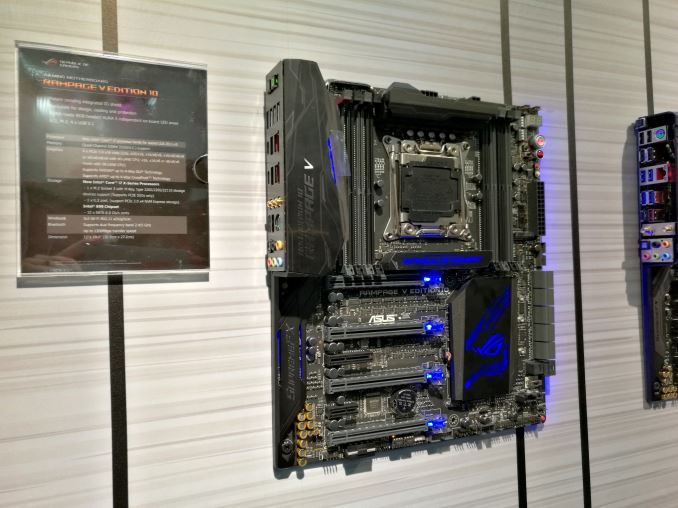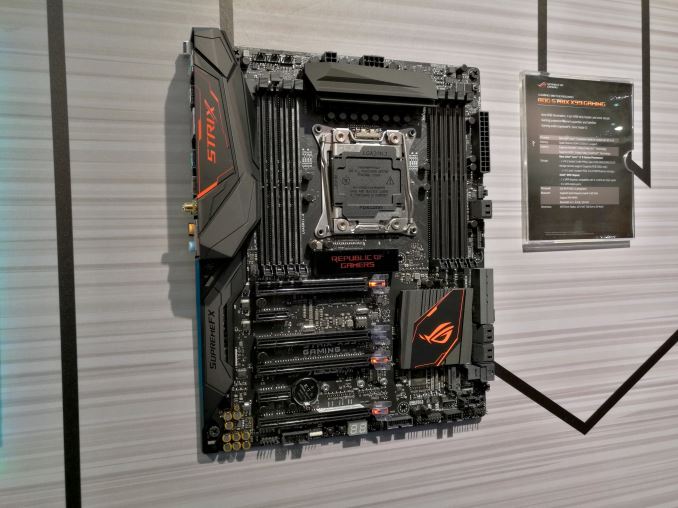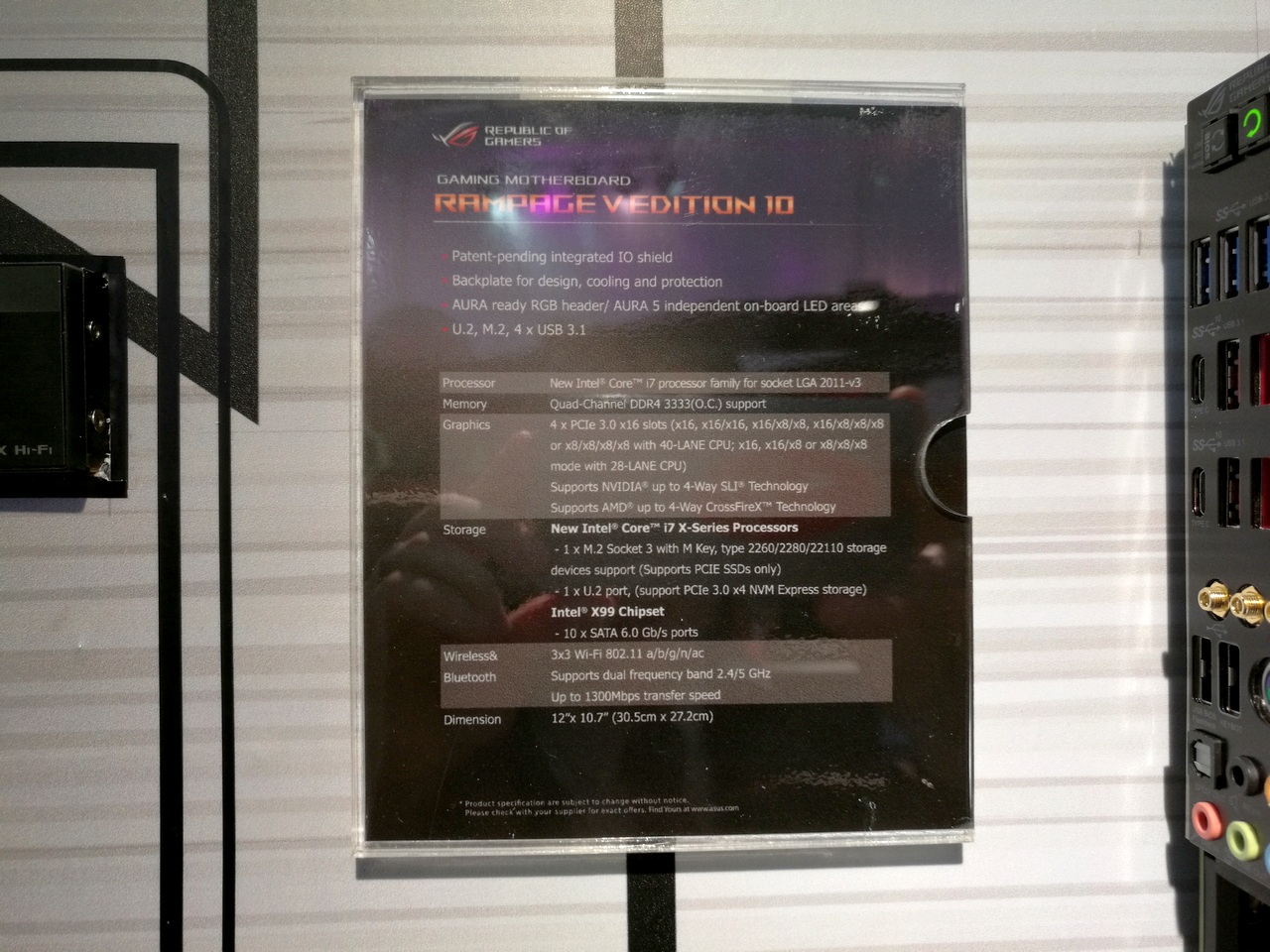ASUS at Computex 2016: The 10 Years of the Republic Of Gamers (ROG) Booth Tour
by Ian Cutress on June 22, 2016 8:00 AM ESTLast year we saw the launch of Intel’s latest mainstream processors using the Skylake microarchitecture, and we’re still a few months away from the Kaby Lake update to the platform with 200-series motherboards. On the high-end desktop side, Intel has very recently launched the Broadwell-E line of CPUs, including the 10-core Core i7-6950X at $1723 (read our review here); however this new line of CPUs uses the LGA2011-v3 socket similar to the previous generation of Haswell-E processors. Keeping the same socket for two generations has been a long-term Intel strategy, so no surprises there. This means that the chipsets also stay the same, and we stay on the X99 chipset for a second generation. Normally in this instance we see the motherboard manufacturers release updated models on the same chipset, adjusting the style and feature-set depending on the market. The key points for the refresh models across all the manufacturers so far has been the increased adoption of U.2 ports, but as ASUS is in the middle of their 10 Year ROG anniversary, to celebrate the occasion they have released a special version of the high-end Rampage V Extreme (RVE) motherboard, normally a $500 model which reviewed earlier this year, into a Rampage V Edition-10 for $600. There’s also a nod to the RGB LED craze that seems to be sweeping the gaming motherboard line, in new models such as the Strix X99 Gaming.
The ASUS Rampage V Edition 10
If we cycle back to the launch of Sandy Bridge-E, and the X79 chipset, the best-selling motherboard of that generation was the ASUS X79 Rampage IV Extreme: a high-cost motherboard that ultimately focused on overclocking and gaming. It was part of a trio of X79 Rampage motherboards, which also included the gaming-focused Rampage IV Formula and the micro-ATX Rampage IV Gene. We reviewed all three in a big ROG article when they were launched, and ASUS has tried to match this success with the X99 platform and the Rampage V Extreme. Similar to how the Rampage IV Extreme had a refresh model, the Rampage IV Black Edition, the RVE gets one for the 10-year anniversary.

Click the image for the full resolution
The most obvious change to the Rampage V Edition 10 is the PCIe slots. Instead of lighting up an LED beside the PCIe slot that needs the graphics card, ASUS has moved to a semi-transparent PCIe latch with an LED underneath that uses a microcontroller for various lighting effects. There are going to be a number of motherboards with this coming in the near future, but the blue lighting here is for the Edition 10.
Compared to the original RVE, the black design is reminiscent of the Rampage IV Black Edition, but there are also a few more updates. ASUS removed the SATA Express ports in the SATA area, and replaced them with a U.2 port that supports PCIe 3.0 x4 drives, like Intel’s SSD 750. The rear panel protector, designed to enhance the aesthetic, is now placed down the side of the motherboard covering most of the audio pathways, although a few filter caps are moved to outside the guard.
Also on the list is the middle PCIe 3.0 x4 slot, which on the original RVE was a full length PCIe 3.0 x4 slot, but here is reduced to an open ended PCIe 3.0 x4 slot. I suspect there will be a few more changes, particularly with Broadwell-E, such as the addition of a second 4-pin DIP switch system on the top right of the board, however if we get the board in to test we’ll go in deeper.
The Rampage V Edition 10 is already on sale, coming in at $600.
ASUS Strix X99 Gaming
The Strix brand at ASUS is having an interesting time. It was originally released on certain graphics cards to signify silent operation, and use the eagle eyes logo to come across as ‘silent but deadly’. Since then, the Strix name has been moved from low-noise to a general ‘value’ proposition model line, pitching behind some of the more well-known ASUS brands. In this case, Strix is meant to signify a fully featured but slightly different to ROG gaming brand with a lot of features but not necessarily ROG branded. I would assume that means that Strix gets a different software package, which might reduce the cost over ROG.

Click the image for the full resolution
The Strix board as shown above looks like a hefty X99 motherboard, using a full array of DIMMs, support for three proper graphics cards, a rear IO/audio combination plate, both SATA Express and U.2 support and multiple fan headers. If only faintly, you can also tell that this model also has the transparent PCIe slot latches similar to the Edition 10, this time in a red/orange color.
The Strix is aimed at 2/3-way high-end desktop systems, and will offer full ‘Aura’ RGB illumination with a separate RGB strip header for a bundled RGB strip to be used with software. It will have a few gaming tools similar to ROG, including Sonic Radar II. The Strix X99 Gaming current retails for around $340.












43 Comments
View All Comments
alphasquadron - Wednesday, June 22, 2016 - link
I used to think that too. I would think that the market for young kids who can afford such huge expensive machines would be quite small as it would it would compose of rich people and not middle class which is much larger market. But as companies make more crazy led shiny cases and even have ram modules that have lights and crap on them, I want to say that either they are just dumb and don't know how to sell stuff or that they have much more real live market data then I do and that these things actually are a good thing to make. I could never see it but maybe these things do provide a good revenue source for the company.Gastec - Wednesday, August 31, 2016 - link
I'm not sure that's the fact in North America. Not since the 15-30 years of age group queued for miles and waited for days to buy $500-600 iPhones.hechacker1 - Wednesday, June 22, 2016 - link
I went with another ATX case because I wanted a silent build, which includes AIO radiators for when you are actually using a Broadwell-E at 100%, along with powerful GPU. They can dump out a lot of heat.Right now my 6800k is using 45w at idle with a 4.3GHz overclock. That's according to the motherboard sensor on the Strix x99 Gaming that was mentioned in this article.
So while 45w isn't that much and can easily be handled by a HSF, at full tilt it's rated for 140w TDP (probably less because the 6800k is cut down).
Anyways, that's to say since I do VR with it, SLI really isn't a factor today and I use a single GPU. What ATX does allow is future further expansion via add in cards, and great and silent cooling. My whole rig has fans that are less than <1000 rpm at all times, and so it's almost always silent.
Bragabondio - Wednesday, June 22, 2016 - link
Nice rig heckhacker! Nowadays the components are getting more power efficient so I am planning on downgrading from 650W power supply to 550W one. As for silent build I am pretty sure I could make my rig as silent as I need it in mATX case (I am ready to go with minimum overclock to keep the noise down). In the eternal dilemma between firepower and mobility I prefer mobility (within a reason).BrokenCrayons - Thursday, June 23, 2016 - link
I'm continuing to use an ATX case for cooling, but the motherboard inside it is mATX since I finished my most recent upgrade. I briefly considered grabbing a smaller case, but it seemed like a waste of $30 to pick one up when there's nothing wrong with the old Lian Li tower on wheels from 2008 aside from the fact that it's got more space than I need right now.milkod2001 - Thursday, June 23, 2016 - link
Because it might be much easier to design full atx LGA 2011-v3 motherboard with all features enabled than micro/mini atx variant. I don't see that as a big issue though. You don't have to get monster case for that. Just get the smallest decent case for full atx mobo and have it sitting under table. Or don't go for LGA 2011-v3 get something simpler if you don't need all features if offers.fanofanand - Wednesday, June 22, 2016 - link
Nice work Ian, thanks for the info!madwolfa - Wednesday, June 22, 2016 - link
What's up with leather jackets?BrokenCrayons - Wednesday, June 22, 2016 - link
It's probably just attire the company's employees believe will appeal to people within their target market.iamkyle - Wednesday, June 22, 2016 - link
Of course, the x99 Edition 10 board doesn't come with 10GbE. But still commands the price premium.Looks like ASUS is all about money instead of delivering actual value.